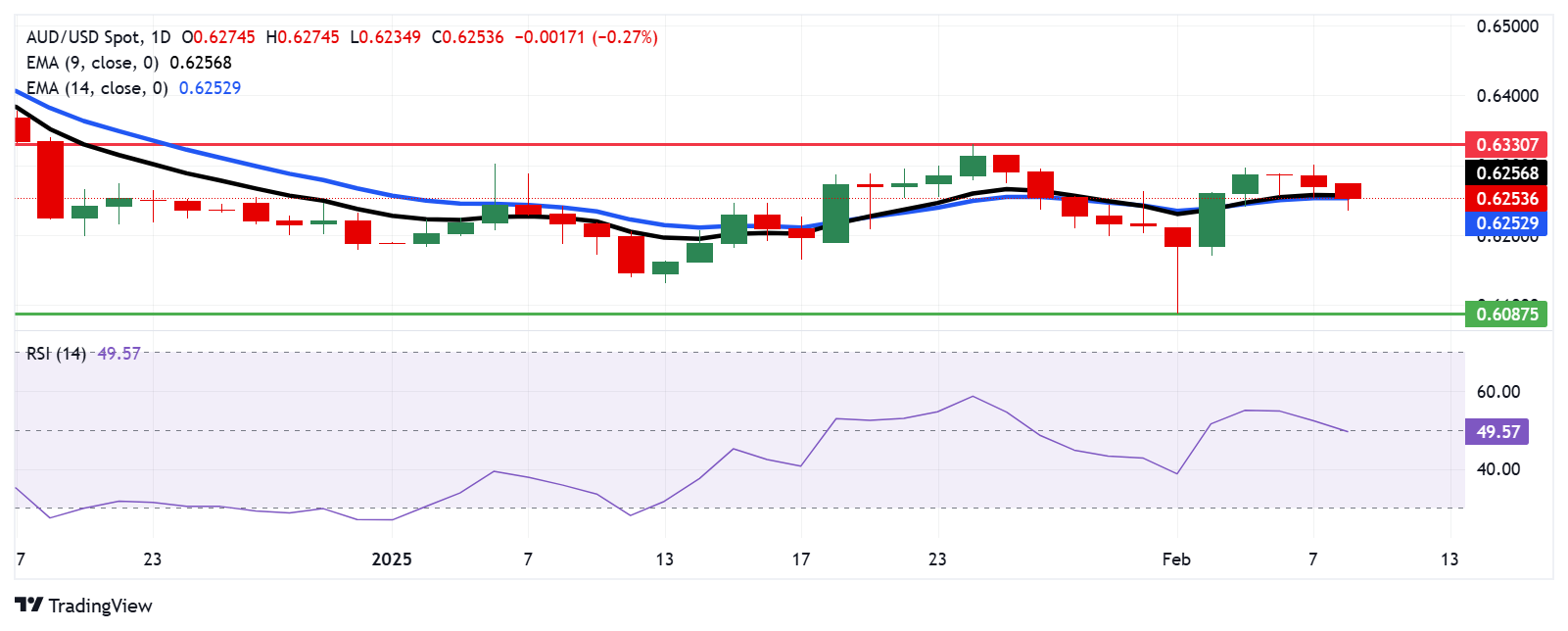
The Australian Dollar loses ground as Trump plans to impose a 25% tariff on all steel and aluminum imports.
The AUD faced challenges as China's retaliatory tariffs on certain US exports have come into effect.
The US Dollar received support as January’s job report reinforced the cautious mood surrounding the Fed’s policy outlook.
The Australian Dollar (AUD) remains under pressure against the US Dollar (USD) for the third consecutive day on Monday, weighed down by escalating trade war concerns. The AUD/USD pair faces downward momentum after US President Donald Trump, speaking aboard Air Force One, announced plans to impose a 25% tariff on all steel and aluminum imports without specifying the affected countries.
President Trump also stated that additional reciprocal tariffs would be unveiled by midweek, set to take effect almost immediately, matching the tariff rates imposed by each country, according to Reuters.
The Australian Dollar also weakened amid growing concerns over the US-China trade war, given Australia's close economic ties with China. A new US levy on Chinese imports took effect last week, while China's retaliatory tariffs on certain US exports began this Monday.
Last week, Trump and Chinese President Xi Jinping had been expected to negotiate a resolution after reports surfaced about a potential phone call between the two leaders. However, that call was reportedly canceled, though hopes remain that it may still take place.
Traders are increasingly confident that the Reserve Bank of Australia (RBA) will cut its 4.35% cash rate at its upcoming meeting later in February, with market expectations suggesting a 95% probability of a reduction to 4.10%. This follows data indicating that underlying inflation has moderated faster than the RBA had anticipated, prompting several major Australian banks to move their forecast for the first rate cut from May to February.
Australian Dollar declines as US Dollar advances amid a cautious Fed
The US Dollar Index (DXY), which measures the US Dollar’s value against six major currencies, rises above 108.00 at the time of writing. The Greenback receives support as the US Federal Reserve (Fed) is now expected to keep interest rates steady this year, following January’s jobs report released on Friday, which indicated slowing job growth but a lower Unemployment Rate.
US Nonfarm Payrolls (NFP) increased by 143,000 in January, significantly below December’s revised figure of 307,000 and the market expectation of 170,000. However, the Unemployment Rate declined slightly to 4% in January from 4.1% in December.
US Initial Jobless Claims rose to 219K for the week ending January 31, as reported by the US Department of Labor (DOL) on Thursday. This print surpasses initial estimates of 213K and was higher than the previous week's revised tally of 208K (from 207K).
Federal Reserve (Fed) Bank of Chicago President Austan Goolsbee mentioned on Friday that inconsistent policy approaches from the US government cause a high level of economic uncertainty that makes it difficult for the Fed to draw a bead on where the economy, and inflation specifically, are likely heading.
Meanwhile, Fed Board of Governors member Adriana Kugler noted that US growth and economic activity remain healthy overall, but noted that progress toward the Fed's inflation goals has been somewhat lopsided, per Reuters.
In an interview with CNBC, Minneapolis Fed President Neel Kashkari said that he would move towards supporting further rate cuts if they see good inflation data and the labor market stays strong
China’s Consumer Price Index (CPI) grew at an annual rate of 0.5% in January, up from 0.1% in December and exceeding the market forecast of 0.4%. On a monthly basis, CPI inflation rose 0.7% in January, compared to December’s flat reading of 0%, though it fell short of the expected 0.8% increase.
China’s Producer Price Index (PPI) declined 2.3% year-over-year in January, matching December’s drop but coming in weaker than the market consensus of a 2.1% decrease.
Technical Analysis: Australian Dollar tests 14-day EMA near 0.6250
The AUD/USD pair hovers near 0.6250 on Monday, testing the 14-day Exponential Moving Average (EMA) on the daily chart. A break below this level could weaken short-term price momentum. The 14-day Relative Strength Index (RSI) is also near the 50 mark, with further movement likely to determine a clearer directional trend.
The AUD/USD pair is testing immediate support at the 14-day EMA of 0.6253. A decisive break below this level could shift the bias bearish, potentially pushing the pair toward 0.6087—the lowest level since April 2020, recorded on February 3.
On the upside, the AUD/USD pair may explore the region around the eight-week high of 0.6330, last reached on January 24.
AUD/USD: Daily Chart
Australian Dollar PRICE Today
The table below shows the percentage change of Australian Dollar (AUD) against listed major currencies today. Australian Dollar was the weakest against the US Dollar.
| USD | EUR | GBP | JPY | CAD | AUD | NZD | CHF | |
|---|---|---|---|---|---|---|---|---|
| USD | 0.24% | 0.11% | 0.44% | 0.45% | 0.32% | 0.36% | 0.27% | |
| EUR | -0.24% | -0.07% | 0.31% | 0.32% | 0.07% | 0.21% | 0.10% | |
| GBP | -0.11% | 0.07% | 0.23% | 0.35% | 0.13% | 0.27% | 0.16% | |
| JPY | -0.44% | -0.31% | -0.23% | -0.04% | -0.05% | -0.08% | -0.17% | |
| CAD | -0.45% | -0.32% | -0.35% | 0.04% | -0.10% | -0.11% | -0.22% | |
| AUD | -0.32% | -0.07% | -0.13% | 0.05% | 0.10% | 0.14% | 0.03% | |
| NZD | -0.36% | -0.21% | -0.27% | 0.08% | 0.11% | -0.14% | -0.10% | |
| CHF | -0.27% | -0.10% | -0.16% | 0.17% | 0.22% | -0.03% | 0.10% |
The heat map shows percentage changes of major currencies against each other. The base currency is picked from the left column, while the quote currency is picked from the top row. For example, if you pick the Australian Dollar from the left column and move along the horizontal line to the US Dollar, the percentage change displayed in the box will represent AUD (base)/USD (quote).
* The content presented above, whether from a third party or not, is considered as general advice only. This article should not be construed as containing investment advice, investment recommendations, an offer of or solicitation for any transactions in financial instruments.



